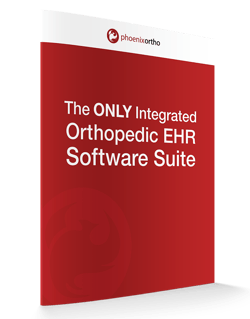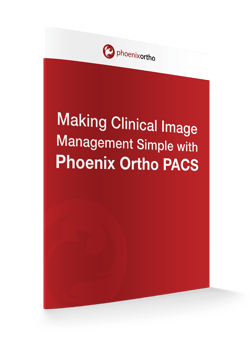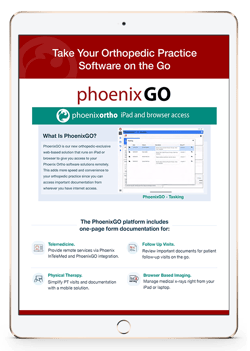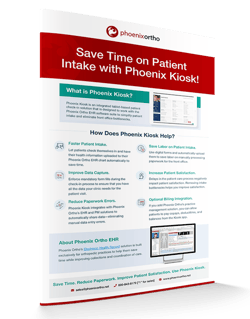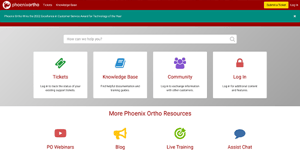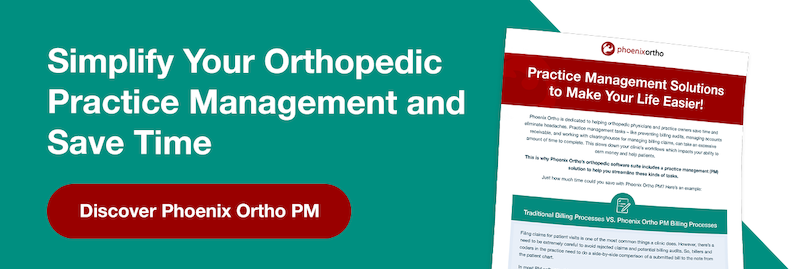Managing an orthopedic practice isn’t always easy. There are countless rules to keep in mind, tons of patients to process (most physicians see between 11 and 20 patients per day, while orthopedists often see more than 50 patients a day), and a lot of paperwork to tackle after each patient visit.
Adding medical practice management (PM) tasks to the already high daily patient workload can create an unreasonable burden on orthopedic physicians. So, finding ways to streamline practice management is crucial for an orthopedic practice.
In today’s post, we’ll define practice management, cover some basic tips for orthopedic practices, and discuss the purpose of a practice management software in modern orthopedics.
What Is Medical Practice Management?
To borrow a practice management definition from the American Academy of Professional Coders (AAPC), practice management is “the responsibility of managing all business aspects of a medical practice including financials, human resources, information technology, compliance, marketing, and operations.”
In short, it’s every aspect of your clinic’s operations from a business perspective. Because medical practice management affects so many different parts of orthopedic clinics, many clinic owners employ a dedicated business manager or practice manager to take charge of their PM workflows.
4 Practice Management Tips for Orthopedic Clinics
So, what are some basic practice management tips that orthopedic physicians and practice owners can employ to improve their business, save time, and reduce headaches from paperwork? Here are a few suggestions:
1. Master the Art of Delegation
While the saying “if you want something done right, do it yourself” does have some merit, orthopedic physicians are often far too busy to do everything themselves. So, it’s important to know when to delegate tasks to assistants, nurses, and office staff as needed.
For example, as mentioned earlier, many orthopedic physicians or practice owners opt to hire a business/practice manager to handle the business side of the clinic. This helps to free up some time so the owner/physician can focus more of their time on patients and less on filing orders for basic supplies, managing staff shift assignments, and other business minutiae.
2. Consider Shifting Your Staffing to Have More People Working Fewer Hours
Balancing your business’ scheduling and staffing to keep the clinic fully staffed for each day it’s open can be a challenge. If you don’t give clinic staff enough hours, they may quit and look for new opportunities elsewhere (or feel forced to take on a second job to cover their bills). On the other hand, having too few staff can lead to paying excessive overtime as employees cover more shifts than they probably should.
Sources cited by Atlassian state that the ideal workload for employees is about “a 7.6 hour work day. That would equate to a 38-hour workweek.” Another expert cited in the Atlassian article stated that working “30-35 hours a week” is more ideal for employee happiness (when combined with regular vacation time).
Consider this: say that your clinic is open for six days a week, from 8:00 a.m. to 7:00 p.m.—that’s an 11-hour day, and 66 hours of open time per week. If your practice only needed two people in the clinic at any given time (aside from yourself or any other orthopedists), that would be 132 hours of labor per week.
Divided amongst three people, that would be 44 hours of time per employee—meaning each person would get four hours of overtime minimum every week. Adding just one more employee cuts each employee down to 33 hours per week—reducing the risk of overtime since one employee could easily cover an extra shift and not go into overtime with 5.5 hour shifts.
How much could this save on labor each month? Let’s assume that your base pay is $15/hour and overtime is time-and-a-half in your state. 132 hours of labor would cost $1,980 per week — or $7,920 in a four-week period. However, if you take 12 hours of that as overtime, you pay $1,800 a week for the first 120 and an additional $270 for the 12 hours of overtime (for a total of $2070 a week). Over four weeks, that’s an additional $360 a month in labor ($8,280 - $7,920).
That doesn’t sound like a lot, right? But, extrapolate that across a whole year, or say that your staffing requirements increase because your clinic gets busier. At that point, the costs of being understaffed and having to pay overtime really add up—not to mention the cost of employee errors or delays caused by overworked clinic staff!
3. Find Ways to Automate Key Processes
There are many workflows in a clinic that could be made much easier by leveraging specialized software to streamline or even wholly automate them. For example, patient intake is often a time-consuming task for both patients and front office staff when done manually.
Having patients painstakingly fill out multiple forms, then having front office staff scan these forms into your Electronic Health Records (EHR) system’s patient note manually is slow and prone to errors (especially if patients have bad handwriting). Here, using a patient intake software to capture patient data at check-in can save a significant amount of time and effort while reducing data entry errors.
Other processes, such as ordering medical images or writing patient prescriptions, could also be streamlined with appropriate software.
4. Send Patient Reminders about Upcoming Appointments
Patient no-shows can be a significant drain on a clinic’s resources. However, they happen all the time. According to data cited by Forbes, “no-shows cost the U.S. health care system more than $150 billion a year and individual physicians an average of $200 per unused time slot.”
After all, during that scheduled time slot, the physician (and supporting staff) needs to be available to see the patient if they just happen to be running late, which delays them from helping other patients in the practice.
There are many potential reasons for a patient no-show. One study on the impact of patient no-shows on service quality broke them into several categories: Patient-related issues, environmental issues, financial issues, and scheduling-related issues.
While clinics cannot do much to curb financial issues that could make the cost of care too much for a patient or environmental issues that make the trip to the clinic unsafe (such as hurricanes, traffic accidents, or other issues), one thing clinics can do to minimize no-shows is sending reminders the day before and the day of a scheduled visit.
This helps to minimize the risk of a patient forgetting about an important visit before it happens. Also, it’s important to verify the patient’s schedule before setting a follow-up visit date—patients aren’t likely to show up if an appointment happens to be set on the day of their daughter’s wedding or during an important business meeting!
What’s the Purpose of a PM Software?
So, what’s the purpose of a practice management software? PM solutions can serve a variety of purposes in a modern orthopedic clinic. However, the major reason a lot of orthopedic clinic owners use a PM software is to make managing their clinic more convenient.
The right practice management system helps to streamline key workflows in your clinic—including things like billing payer organizations, sharing important information between front office staff and physicians, managing durable medical equipment (DME) inventory, etc.
There are as many uses for practice management software in orthopedic clinics as there are practice owners who use them. Some like to just have something optimized for their needs to help them save time. Others use PM solutions to increase accountability within their clinic. Some use it to help keep in line with regulatory obligations in their region.
Of course, not all practice management solutions are created equally—some may be better for your needs than others!
Why You Need an Orthopedic-Exclusive Software Vendor
Why go with software developed by an orthopedic-exclusive vendor? One reason is for the increased convenience and time saved.
Unlike software platforms developed for a primary care facility, an orthopedic-exclusive software suite will be optimized to specifically address your orthopedic practice’s needs. So, instead of sifting through dozens of menus and screens to find the one orthopedic template in the system, all you are presented with is orthopedic-focused templates and menus.
This helps everyone in your practice save time and labor—which helps practice owners reduce labor costs and get more done with less time spent. Additionally, with an ortho-exclusive software vendor, you know that all of that vendor’s resources are going into upgrades and updates for orthopedic features.
As the only orthopedic-exclusive EHR, PM, and PACS vendor, Phoenix Ortho brings a comprehensive suite of solutions that are optimized for your orthopedic practice’s needs. Why wait? Request a demo of Phoenix Ortho today!
Schedule a 1:1
Get in touch with Phoenix Ortho to learn more about how you can save time, money, and mouse clicks with an orthopedic-specific EHR.





